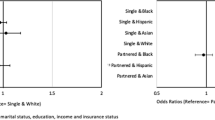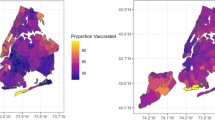Abstract
Deaths attributable to hepatitis C (HCV) infection are increasing in the USA even as highly effective treatments become available. Neighborhood-level inequalities create barriers to care and treatment for many vulnerable populations. We seek to characterize citywide trends in HCV mortality rates over time and identify and describe neighborhoods in New York City (NYC) with disproportionately high rates and associated factors. We used a multiple cause of death (MCOD) definition for HCV mortality. Cases identified between January 1, 2006, and December 31, 2014, were geocoded to NYC census tracts (CT). We calculated age-adjusted HCV mortality rates and identified spatial clustering using a local Moran’s I test. Temporal trends were analyzed using joinpoint regression. A multistep global and local Poisson modeling approach was used to test for neighborhood associations with sociodemographic indicators. During the study period, 3697 HCV-related deaths occurred in NYC, with an average annual percent increase of 2.6% (p = 0.02). The HCV mortality rates ranged from 0 to 373.6 per 100,000 by CT, and cluster analysis identified significant clustering of HCV mortality (I = 0.23). Regression identified positive associations between HCV mortality and the proportion of non-Hispanic black or Hispanic residents, neighborhood poverty, education, and non-English-speaking households. Local regression estimates identified spatially varying patterns in these associations. The rates of HCV mortality in NYC are increasing and vary by neighborhood. HCV mortality is associated with many indicators of geographic inequality. Results identified neighborhoods in greatest need for place-based interventions to address social determinants that may perpetuate inequalities in HCV mortality.




Similar content being viewed by others
References
Ly KN, Xing J, Klevens RM, Jiles RB, Ward JW, Holmberg SD. The increasing burden of mortality from viral hepatitis in the United States between 1999 and 2007. Ann Intern Med. 2012;156(4):271–8.
Oramasionwu CU, Toliver JC, Johnson TL, Moore HN, Frei CR. National trends in hospitalization and mortality rates for patients with HIV, HCV, or HIV/HCV coinfection from 1996-2010 in the United States: a cross-sectional study. BMC Infect Dis. 2014;14:536.
Pinchoff J, Drobnik A, Bornschlegel K, et al. Deaths among people with hepatitis C in New York City, 2000-2011. Clin Infect Dis. 2014;58(8):1047–54.
Razavi H, Elkhoury AC, Elbasha E, et al. Chronic hepatitis C virus (HCV) disease burden and cost in the United States. Hepatology. 2013;57(6):2164–70.
Moorman AC, Xing J, Ko S, et al. Late diagnosis of hepatitis C virus infection in the Chronic Hepatitis Cohort Study (CHeCS): missed opportunities for intervention. Hepatology. 2015;61(5):1479–84.
Spradling PR, Rupp L, Moorman AC, et al. Hepatitis B and C virus infection among 1.2 million persons with access to care: factors associated with testing and infection prevalence. Clin Infect Dis. 2012;55(8):1047–55.
Schaeffer S, Khalili M. Reasons for HCV non-treatment in underserved African Americans: implications for treatment with new therapeutics. Ann Hepatol. 2015;14(2):234–42.
Armstrong GL, Wasley A, Simard EP, McQuillan GM, Kuhnert WL, Alter MJ. The prevalence of hepatitis C virus infection in the United States, 1999 through 2002. Ann Intern Med. 2006;144(10):705–14.
Stepanova M, Kanwal F, El-Serag HB, Younossi ZM. Insurance status and treatment candidacy of hepatitis C patients: analysis of population-based data from the United States. Hepatology. 2011;53(3):737–45.
Tohme RA, Xing J, Liao Y, Holmberg SD. Hepatitis C testing, infection, and linkage to care among racial and ethnic minorities in the United States, 2009-2010. Am J Public Health. 2013;103(1):112–9.
Levin KA, Dundas R, Miller M, McCartney G. Socioeconomic and geographic inequalities in adolescent smoking: a multilevel cross-sectional study of 15 year olds in Scotland. Soc Sci Med. 2014;107:162–70.
Watson T. Inequality and the measurement of residential segregation by income in American neighborhoods. Rev Income Wealth. 2009;55(3):820–44.
Tunstall HV, Shaw M, Dorling D. Places and health. J Epidemiol Community Health. 2004;58(1):6–10.
Parchman ML. Small area variation analysis: a tool for primary care research. Fam Med. 1995;27(4):272–6.
Diehr P, Cain K, Ye Z, Abdul-Salam F. Small area variation analysis. Methods for comparing several diagnosis-related groups. Med Care. 1993;31(5 Suppl):YS45–53.
Miranda ML, Ferranti J, Strauss B, Neelon B, Califf RM. Geographic health information systems: a platform to support the ‘triple aim’. Health Aff (Millwood). 2013;32(9):1608–15.
Pickett KE, Pearl M. Multilevel analyses of neighbourhood socioeconomic context and health outcomes: a critical review. J Epidemiol Community Health. 2001;55(2):111–22.
Balter S, Stark JH, Kennedy J, Bornschlegel K, Konty K. Estimating the prevalence of hepatitis C infection in New York City using surveillance data. Epidemiol Infect. 2014;142(2):262–9.
Greene SK, Levin-Rector A, Hadler JL, Fine AD. Disparities in reportable communicable disease incidence by census tract-level poverty, New York City, 2006-2013. Am J Public Health. 2015;105(9):e27–34.
United States Census Bureau. State and County QuickFacts. Data derived from Population Estimates, American Community Survey, Census of Population and Housing, County Business Patterns, Economic Census, Survey of Business Owners, Building Permits, Census of Governments 2015.
New York City Census FactFinder. Department of City Planning. New York, NY: The City of New York; 2015.
O’Campo P. Invited commentary: advancing theory and methods for multilevel models of residential neighborhoods and health. Am J Epidemiol. 2003;157(1):9–13.
World Health Organization. International Classification of Diseases. 10th Revision. Geneva, Canton of Geneva: World Health Organization; 1998.
Mahajan R, Xing J, Liu SJ, et al. Mortality among persons in care with hepatitis C virus infection: the Chronic Hepatitis Cohort Study (CHeCS), 2006-2010. Clin Infect Dis. 2014;58(8):1055–61.
Meyers DJ, Hood ME, Stopka TJ. HIV and hepatitis C mortality in Massachusetts, 2002-2011: spatial cluster and trend analysis of HIV and HCV using multiple cause of death. PLoS One. 2014;9(12):e114822.
Geo Portal [computer program]. New York, New York: The City of New York; 2009.
RJ, Schoenborn CA. Age adjustment using the 2000 projected U.S. population. Healthy People Statistical Notes, no. 20. Hyattsville: National Center for Health Statistics; 2001.
US Census Bureau. 2009–2013 American Community Survey 5-year estimates. Am Fact Finder.
Kim HJ, Fay MP, Feuer EJ, Midthune DN. Permutation tests for joinpoint regression with applications to cancer rates. Stat Med. 2000;19(3):335–51.
Weisent J, Rohrbach B, Dunn JR. Socioeconomic determinants of geographic disparities in campylobacteriosis risk: a comparison of global and local modeling approaches. Int J Health Geogr. 2012;11(1):45.
Nakaya T, Fotheringham AS, Brunsdon C, Charlton M. Geographically weighted Poisson regression for disease association mapping. Stat Med. 2005;24(17):2695–717.
Hogrebe MC, Tate WF. Place, poverty, and algebra: a statewide comparative spatial analysis of variable relationships. J Math Educ Teach.Coll. 2012;3(2):12–24.
Wheeler D, Tiefelsdorf M. Multicollinearity and correlation among local regression coefficients in geographically weighted regression. J Geogr Syst. 2005;7(2):161–87.
Nakaya T, Fotheringham A, Charlton M, Brundson C. Semiparametric geographically weighted generalised linear modelling: The concept and implementation using GWR4. In: Brunsdon C, Singleton A, editors. Geocomputation: A Practical Primer. Sage: London; 2014.
Alter MJ, Kruszon-Moran D, Nainan OV, et al. The prevalence of hepatitis C virus infection in the United States, 1988 through 1994. N Engl J Med. 1999;341(8):556–62.
Chandra A, Skinner J. Geography and Racial Health Disparities. Cambridge: National bureau of economic research. Cambridge, MA; 2003.
Ruiz JM, Hamann HA, Mehl MR, O’Connor M-F. The Hispanic health paradox: from epidemiological phenomenon to contribution opportunities for psychological science. Group Process Intergroup Relat. 2016;19(4):462–76.
Huh J, Prause JA, Dooley CD. The impact of nativity on chronic diseases, self-rated health and comorbidity status of Asian and Hispanic immigrants. J Immigr Minor Health. 2008;10(2):103–18.
Hellard M, Sacks-Davis R, Doyle J. Hepatitis C elimination by 2030 through treatment and prevention: think global, act in local networks. J Epidemiol Commun Health. 2016. doi:10.1136/jech-2015-205454.
Shepard CW, Gortakowski HW, Nasrallah H, Cutler BH, Begier EM. Using GIS-based density maps of HIV surveillance data to identify previously unrecognized geographic foci of HIV burden in an urban epidemic. Public Health Rep. 2011;126(5):741–9.
Janelle DG, Warf, B, Hansen, K, ed WorldMinds: Geographical Perspectives on 100 Problems: commemorating the 100th anniversary of the Association of American Geographers 1904–2004. Norwell, MA: Springer-Science+Business Media, B.V.; 2004.
Author information
Authors and Affiliations
Corresponding author
Additional information
Thumbnail Sketch: Hepatitis C (HCV) mortality rates are increasing in the USA, exceeding those of HIV in many communities. HCV disproportionately affects persons living in poverty, and community-based interventions may be particularly useful to target high-risk populations. This is the first study examining inequalities in HCV mortality by census tract in New York City (NYC). The study found increasing rates of HCV mortality in NYC and over two thirds of decedents to be less than 65 years of age. HCV mortality rates were associated with multiple indicators of socioeconomic inequality and varied by neighborhood.
Rights and permissions
About this article
Cite this article
Ford, M.M., Desai, P.S., Maduro, G. et al. Neighborhood Inequalities in Hepatitis C Mortality: Spatial and Temporal Patterns and Associated Factors. J Urban Health 94, 746–755 (2017). https://doi.org/10.1007/s11524-017-0174-x
Published:
Issue Date:
DOI: https://doi.org/10.1007/s11524-017-0174-x




